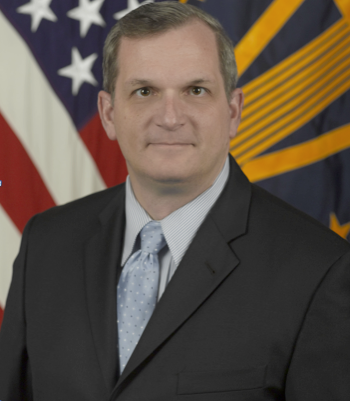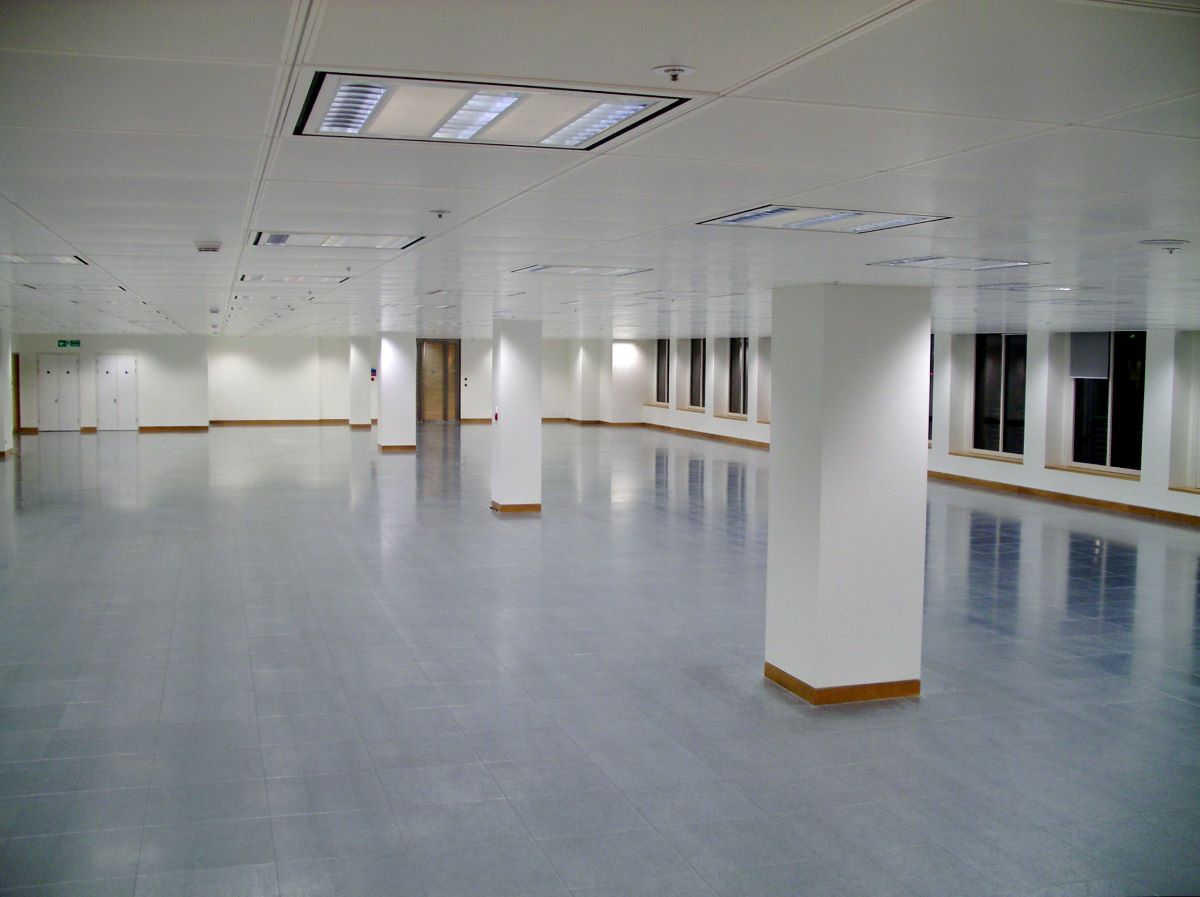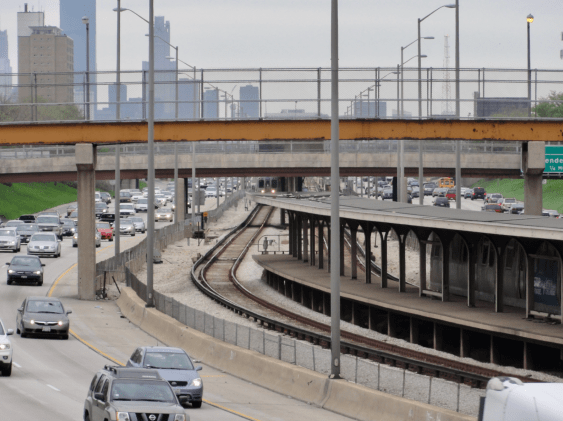Q & A With a Military Architect of the Smart Growth Revolution
11:05 AM EDT on June 21, 2013
We’ve spent this week exploring the ways in which the Department of Defense is overhauling its master planning procedures to turn their sprawling military bases into compact, walkable communities with mixed-use development and town centers. They’re hoping to bring back some of the people who have moved off base in recent decades, with the promise of a more livable community. Streetsblog had the chance to talk to Michael McAndrew, director of facility investment and management for the deputy under secretary of defense. McAndrew has helped guide this process from the inside.
Tanya Snyder: When did the military establishment realize it needed to do something about energy use?

Michael McAndrew: I didn’t pursue revamping the installation master plan process because of energy, directly. It’s a benefit, don’t get me wrong. But I had seen some problems out there that kind of alarmed me. In particular, I see a lot of one-story buildings, a lot of sprawl, buildings with a lot of space in between.
And at that point, our previous deputy undersecretary was pushing a lot of energy initiatives. One of the things that drive a lot of energy use for us is gas and a lot of vehicles on base. One way we thought to solve two problems at one time was to build higher, taller buildings on base and bring them closer together. That way we would have less roads, less need for vehicles.
So we took a look at what our master planning policies were at the time, and they were last crafted and edited back in the mid 80s. Any document that old obviously needs to have a fresh set of eyes on it, thinking about what we’re doing today and in the near future. So, we put together a team to go out there -- with contract support that does private sector master planning, community planning -- and we sat down and talked about where we want to go. And we let ‘em go.
TS: That was Mark Gillem’s team?
MM: Yes, we used him as our advisor. And they came back with a good product that pushes a lot of mixed-use facilities, a higher density on base, and it was just kind of [filling] all the bills to plan for future.
And I say “plan for the future” because installation master planning looks out about 20 years.
TS: You talked about some of the problems with single-story development and sprawl and space between buildings. What harm does that kind of development cause on the base?
MM: One time I was over at Ramstein Air Force Base in Germany, and the people there were talking to me about how it gets so congested on the roads. They were talking about traffic flow and the amount of cars. And they had some vacant buildings and they were getting ready to do some moves on the base, and I started saying, ‘Well if you knock down certain buildings here and here, and consolidate them, that’s going to free up space, and you can reroute traffic.’ They didn’t go into a lot of discussion. But then suddenly the traffic problem went away.
Remember, the sprawl didn’t come about in one or two or three years. The situation we’re in now, we got to over 50 or 60 years. You fix it one building at a time.
I think a lot of services we were working with realized there was a problem of the way we budget around here. They only have so much money, so they only put up a smaller building instead of thinking about how an entire series of buildings or a lane or an alley or a street would look in the future.
And it’s hard, and I respect that, because there is only so much budget that we have that we can effect in any one year. Hopefully this master planning will help them think more comprehensively about their base so that when they do have to do one project they can think about others. So instead of building a one-story building they can build a two- or three-story building. There are certainly a lot of recapitalization requirements out there, and they can combine more of these organizations into one building, rather than have the standalone organization buildings that they have now.
TS: That’s a good point you make, that maybe you have different ideas and guidance about planning now but the resources are still the same. So somebody needs this one small facility and you come with this very good idea of combining it with other facilities into one building, but then you’re building a multimillion-dollar building. Is that still a hard case to make, resource-wise?
MM: Absolutely, and especially now. When we started doing the master planning we weren’t thinking, ‘Gee, the budget’s going to get cut by $50 billion a year for the next 10 years.’
TS: The sequestration.
MM: Master planning allows you to be flexible. It’s a planning document, it’s not a contract; it doesn’t lock you in. It’s a flexible document that changes over time based on circumstances. But it should be referred to when they start looking at what their requirements are and they have to make the argument for the long term: Is it really better to do the one building or is it better to do a larger building, and kill several requirements that they may have in the out years, at one time. And those are business decisions they have to make.
TS: And what’s your background? Do you have a planning or architecture or urban design background?
MM: Noooo. I started as program analyst. Most of my work was done in BRAC [Base Closure and Realignment Commission] and I was deputy director of housing for the Department of Defense, far too long ago. No, I don’t have it, and that’s why we relied on people like Mark Gillem to say, ‘Is this what private sector is doing?’
TS: I would think that BRAC would offer a lot of opportunities for this kind of redevelopment because you’re closing and consolidating programs. Is this a really important time for this UFC [Unified Facilities Criteria] to be in effect?
MM: Actually, in order to affect the last BRAC round, we would have needed this about five or six years ago. It’s a little late for that. Plus, everybody thinks, ‘Gee, you put this master plan out there and everybody’s going to follow it tomorrow.’
Remember, the sprawl didn’t come about in one or two or three years. The situation we’re in now, we got to over 50 or 60 years. I don’t anticipate that over the next decade we’ll fix everything with this new guidance. We don’t replace bases, we replace buildings. So you do it one building at a time.
We’ll continue doing the training to make people aware of their responsibilities and how they should be using this document as they plan for the future. So we’ll see the implementation over a long period of time and hopefully make those changes kind of slow and get people used to seeing it, rather than hit them over the head with a hammer and have them pull back.
As the energy requirements came out, we saw roads as being one of the things that cause problems – so if you limit road space, parking space, that will help with your energy footprint and greenhouse gases.
TS: How long do you think it will take? Are there some bases that are ready for a lot of redevelopment that might see a more urban model pretty quickly? How long do you think it will be before some of the benefits of smart growth and urban development are realized on a broad level?
MM: I wouldn’t see it my lifetime. I think we’re talking decades, because of the amount of money it’s going to take. most bases are lucky to get one or two projects a year, or maybe every five years. Bases don’t get a lot of money every year to do construction.
TS: It’s interesting to hear you talk so much about the scarcity of dollars. As Mark Gillem mentioned, the land is there and it’s abundant, which is not the case for most development. That is a difficult scenario, in which land is so abundant but the money to build is lacking.
MM: It’s because the land is available that makes it hard. That drives people to want to put in another road and build just that one building they need, to meet that one requirement. And that’s what got us into the situation we’re in. And it happened over time. It isn’t something they decided we’re going to do. It was when people were jumping in cars everywhere they went.
TS: Is this precipitated by the fact that people are saying they don’t want to jump in cars for everything anymore?
MM: No, we’re trying to stop them from doing that.
TS: It’s not something they’re asking for.
MM: No, we’re trying to adjust people’s behaviors with this document. We’re trying to get people to be less reliant on those vehicles. If we put the buildings closer together, if we put the parking farther out and garage it, we’re trying to change people’s behavior so they have to walk where they want to go. But then we have to make things available within that walking distance. So we have to think about what businesses we should put in.
A little bit of a struggle has been, what do we do with family housing? The vast majority of our housing in the United States is now privatized. It’s on base but it’s not ours, technically; it’s by a private developer. So trying to get mixed-use in there is more difficult now. I can’t just tell a private developer, ‘Move your houses over here, do this and do that.’ We can’t direct that kind of stuff anymore.
So what are we going to use for mixed development? We have barracks that we can use, the unaccompanied housing -- put that closer to where they work, so they don’t have jump in cars to go to the exchanges or the commissaries. Those are the planning things we have to think about for the next few years.
TS: Where have you already seen some dramatic changes?
MM: There are some places where we did this without the UFC in place. When we started doing some of the privatizations at Fort Belvoir, we put storefronts with the housing. So there’s a little bit of mixed-use area that gets a lot of use by the homeowners in these very walkable areas. And I know the lifestyle center that the Army and Air Force Exchange Service has been developing in, I believe, Fort Bliss was one, and Fort Lewis was another.
TS: You mentioned the exchanges. I don’t know how similar an exchange is to a regular shopping center. But on a base, you have range and training and airstrips and security considerations that not all communities have. Can you talk about some of the unique challenges that a planner or developer might not have to deal with outside a military base that you all do?
MM: Fortunately, most of what we do inside our fence line is much like almost any community out there. But the problem is access. We have to plan for a restricted community and some businesses don’t work well in a closed environment because you have a limited audience. You have to be careful about where you plan those so you get a throughput of people, a customer base.
TS: As you talk, I’m realizing how much work this is and how deeply ingrained the auto-dependency is on military bases. Was it really just traffic that was so extreme that the military realized, we have to change everything?
MM: For me, what was so extreme was having guidance from 1986 guide where we’re going in 2010 and beyond. The culture was different then, the prices of gas were different then, the prices of everything were different then.
And it was an opportune time, as the energy requirements came out, we saw roads as being one of the things that cause problems because cars like to be on them – so if you limit road space, parking space, that will help with your energy footprint and greenhouse gases.
Read More:
Stay in touch
Sign up for our free newsletter
More from Streetsblog USA
Wednesday’s Headlines Are Running on Empty
Fewer commutes to downtown offices means less money to fund transit services, even as money for autocentric infrastructure keeps right on flowing.
What to Say When Someone Claims ‘No One Bikes or Walks in Bad Weather’
Yes, sustainable modes are more vulnerable to bad weather. But that's why we should invest more in them — not less.
Chicago Announces $2M Federal Grant to Address Harms Caused By I-290
The Mayor's Office says the money will fund "improvements for people walking and bicycling on existing streets and paths surrounding and crossing the corridor."
Car Crashes by City Workers Cost NYC Taxpayers $180M in Payouts Last Year: Report
A record number of victims of crashes involving city employees in city-owned cars filed claims in fiscal year 2023 — and settlements with victims have jumped 23 percent, a new report shows.
Tuesday’s Headlines Are Driving Inflation
Driving — specifically, the cost of car ownership — is one of the main factors behind inflation, according to the Eno Center for Transportation.




